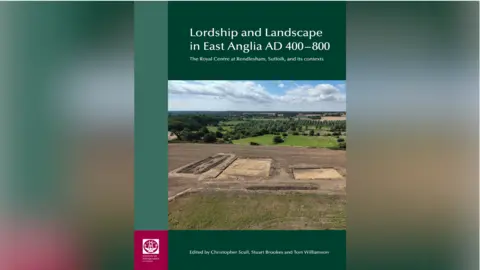New book details Rendlesham's royal finds
 Suffolk County Council
Suffolk County CouncilResearch into how a village was once the centre of East Anglian royalty has been shared in a new book.
Archaeological fieldwork carried out in Rendlesham, Suffolk, uncovered 5,000 items - including gold and garnet dress accessories, weapon fittings and coins.
The research work was co-ordinated by Suffolk County Council's Archaeological Service (SCCAS) and collated into the book.
Prof Christopher Scull, who led the research, said the team had been able to show Rendlesham as an area where kings stayed, dispensed justice, feasted and had coinage minted.
 Suffolk County Council
Suffolk County CouncilThe work in Rendlesham began in 2008 when a local landowner contacted SCCAS for assistance after a number of archaeological finds.
Over the course of 10 years, investigations identified the area as an East Anglian royal seat.
Experts determined that for 150 years - from AD 580 to 730 - Rendlesham was the focus of royal power in the region, were kings stayed, dispensed justice, feasted and had coinage minted.
A large royal settlement covering an area approximately the size of 70 football pitches was believed to have thrived here.
 Suffolk County Council
Suffolk County Council"These societies were more sophisticated, and more widely connected, than we previously thought," Prof Scull said.
"We are able to show how local leaders from what is now south-east Suffolk established a wider rule over what is now Norfolk and Suffolk, and how they ruled their kingdom through royal centres such as Rendlesham.
"We also believe that the legacy of Roman rule helped shape the geography of the early East Anglian kingdom."
Many of the metalwork finds from the area have been acquired by Colchester and Ipswich Museum Service.
They are expected to go on permanent display at Ipswich Museum when it reopens.
 Suffolk County Council
Suffolk County CouncilThe new book on the finds, called Lordship and Landscape in East Anglia AD 400-800, is available to buy.
Phillip Faircloth-Mutton, cabinet member for environment, communities and equality at the county council, said Suffolk continued to "reveal its extraordinary history and international significance".
"We owe the discovery and understandings of the royal settlement at Rendlesham to the landowner for allowing access, to the four local metal detectorists who were instrumental in discovering the site, to all the professionals and academics involved in realising the importance of what has been found, and to the Suffolk County Council Archaeological Service for coordinating," he added.
Follow Suffolk news on BBC Sounds, Facebook, Instagram and X.
